Birdfinding.info ⇒ Locally common in some parts of its range, including: Senegal (along the coast south of Dakar, and at Niokolo-Koba National Park); Gambia (throughout); southern Mali (Bamako); northern Ghana (Tono Dam); coastal Ghana; northern Cameroon (Waza National Park); western Ethiopia (Gambela); western Uganda (Murchison Falls National Park); and western Kenya (Budalangi). In southern Spain, the most consistent site appears to be Motril, east of Málaga; and on Guadeloupe, the eastern tip (Pointe des Chateaux). On Hawaii’s Big Island, small numbers were reported sporadically in the 2000s and ‘10s along the Kona coast, especially near Kealakekua Bay.
Black-rumped Waxbill
Estrilda troglodytes
Sahel region of Africa; widely introduced elsewhere.
Inhabits dry grasslands, brush and scrubby woodlands between the Sahara and the Equator from Senegal and southwestern Mauritania east to northwestern Eritrea, and locally south to Liberia, coastal Ghana, northeastern D.R. Congo, and northern Tanzania.
Introduced populations appear well-established in southern Spain (the Guadalquivir Delta and along the Mediterranean coast from Málaga to Motril, and possibly farther east), in the Lesser Antilles on Guadeloupe and La Désirade, and more tenuously on Martinique, Singapore, and possibly also Hawaii’s Big Island.
Identification
A small, slender, pale-gray-to-sandy-brown finch with a vivid crimson mask, coral-red bill, and usually a pink blush on the underparts, shading to red on the lower belly.
Easily confused with Common and Arabian Waxbills (see below for notes on distinguishing them).
Unlike Common, Black-rumped’s tail is mostly black with white outer edges, and the vent is whitish.
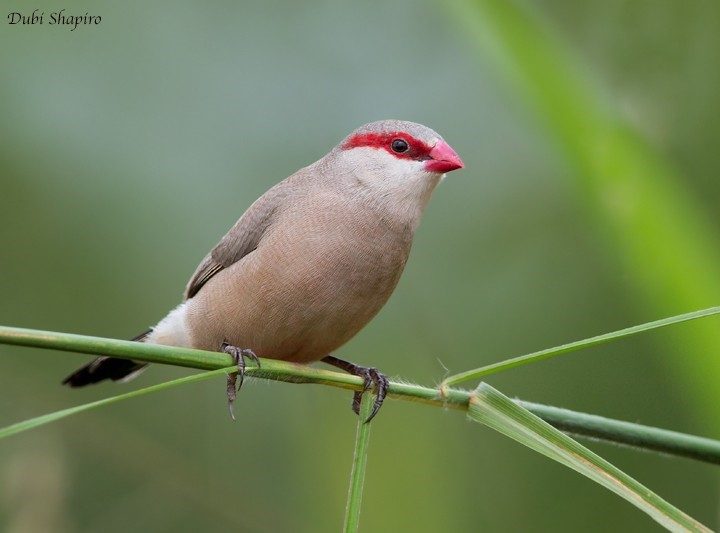
Black-rumped Waxbill, showing a subtle vinaceous hue on the underparts—note the white vent and black tail. (Winneba Plains, Ghana; August 12, 2016.) © Dubi Shapiro
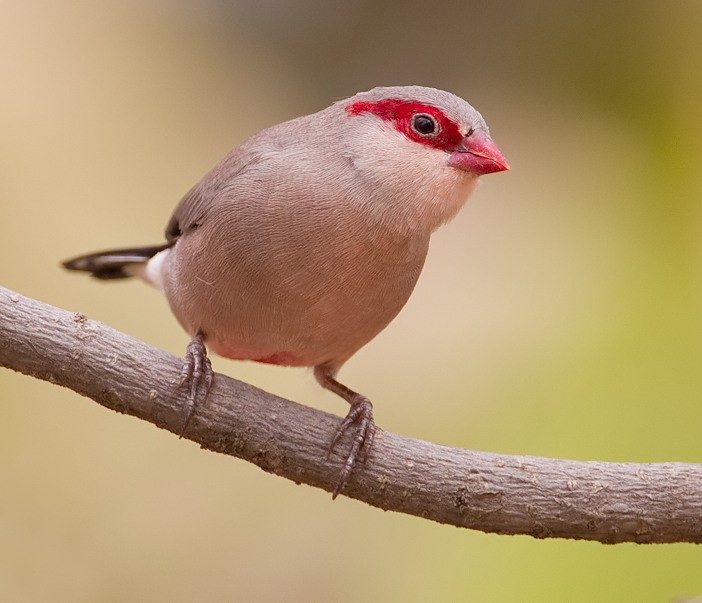
Black-rumped Waxbill, appearing mostly pinkish overall. (Tendaba, Gambia; February 11, 2012.) © Paul Cools

Black-rumped Waxbill, showing generally sandy plumage with only a slight reddish patch on the lower belly. (Faraba Batang Bush Track, Gambia; December 12, 2013.) © Matthias Hofstede

Black-rumped Waxbill, showing a pinkish hue on the underparts—note the white vent. (Sungei Pandan, Singapore; June 7, 2011.) © Francis Yap
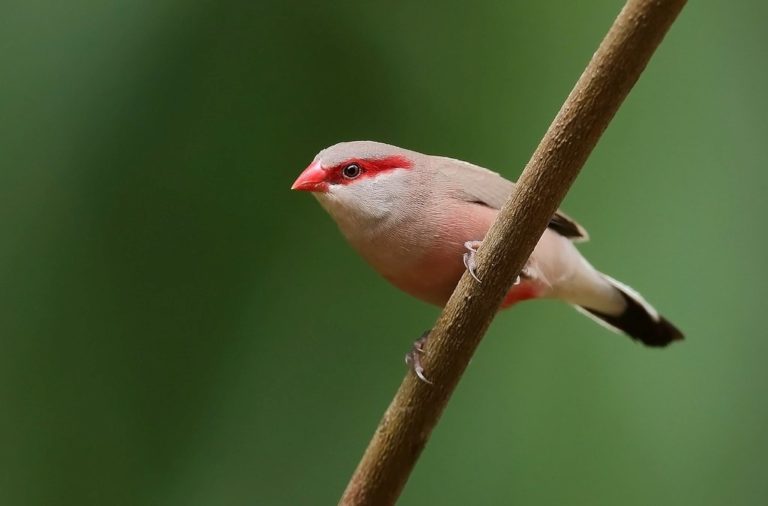
Black-rumped Waxbill, appearing mostly pinkish below with a contrastingly whitish vent—note the black tail with white edge. (Lor Halus, Singapore; August 2, 2018.) © Sheau Torng Lim
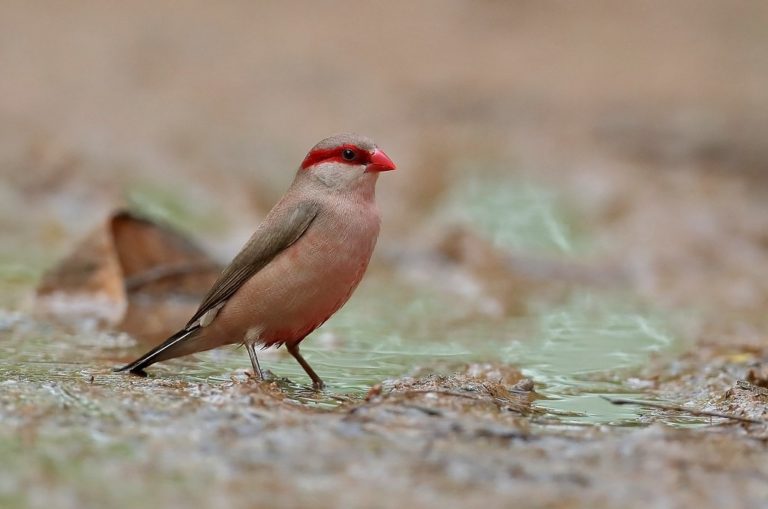
Black-rumped Waxbill, appearing mostly pinkish below, including the vent. (Lor Halus, Singapore; August 2, 2018.) © Sheau Torng Lim
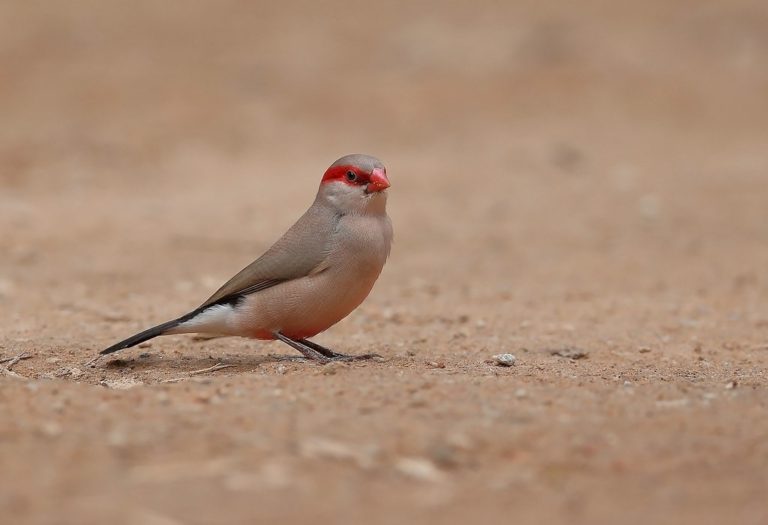
Black-rumped Waxbill, appearing mostly pinkish below with a contrastingly whitish vent. (Lor Halus, Singapore; August 3, 2018.) © Sheau Torng Lim

Black-rumped Waxbill, bathing. (Lor Halus, Singapore; August 13, 2018.) © Sheau Torng Lim

Black-rumped Waxbill, with pink on underparts showing as red streaks when wet. (Lor Halus, Singapore; August 13, 2018.) © Sheau Torng Lim

Black-rumped Waxbill, in the hand, allowing a close enough view to detect the subtle barring. (Cártama, La Aljaima. Río Guadalhorce, Málaga, Andalucía, Spain; June 9, 2012.) © José A Cortés Guerrero
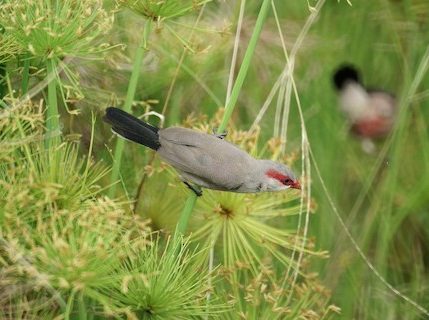
Black-rumped Waxbill, showing sandy-gray upperparts and blackish tail. (Bishan-Ang Mo Kio Park, Singapore; April 20, 2018.) © Kian Guan Tay
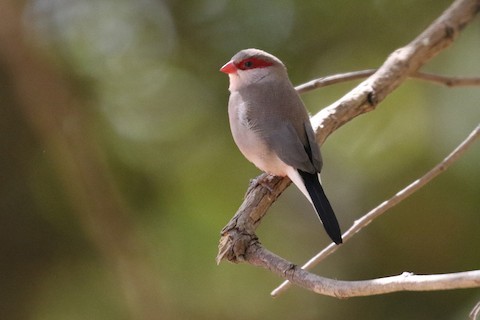
Black-rumped Waxbill, showing sandy-gray upperparts, blackish tail, and white vent. (Farasutu Forest, Gambia; February 8, 2020.) © Jacques Vanheuverswyn
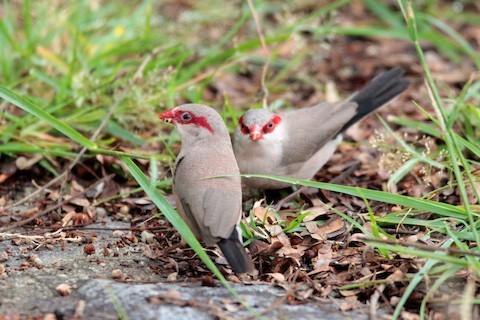
Black-rumped Waxbills, showing sandy-gray upperparts and blackish tails. (Bishan-Ang Mo Kio Park, Singapore; March 29, 2018.) © Fadzun A.
Immature plumage is like the adult’s, but plainer and without the red mask, which is usually replaced by a small blackish mask. The bill is black, as in other immature waxbills.
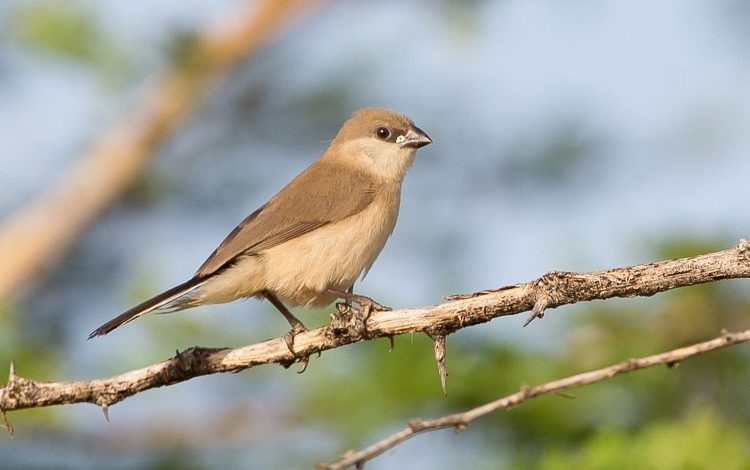
Black-rumped Waxbill, immature showing typical plumage and bill color. (Massenya, Chad; September 27, 2016.) © Paul van Giersbergen
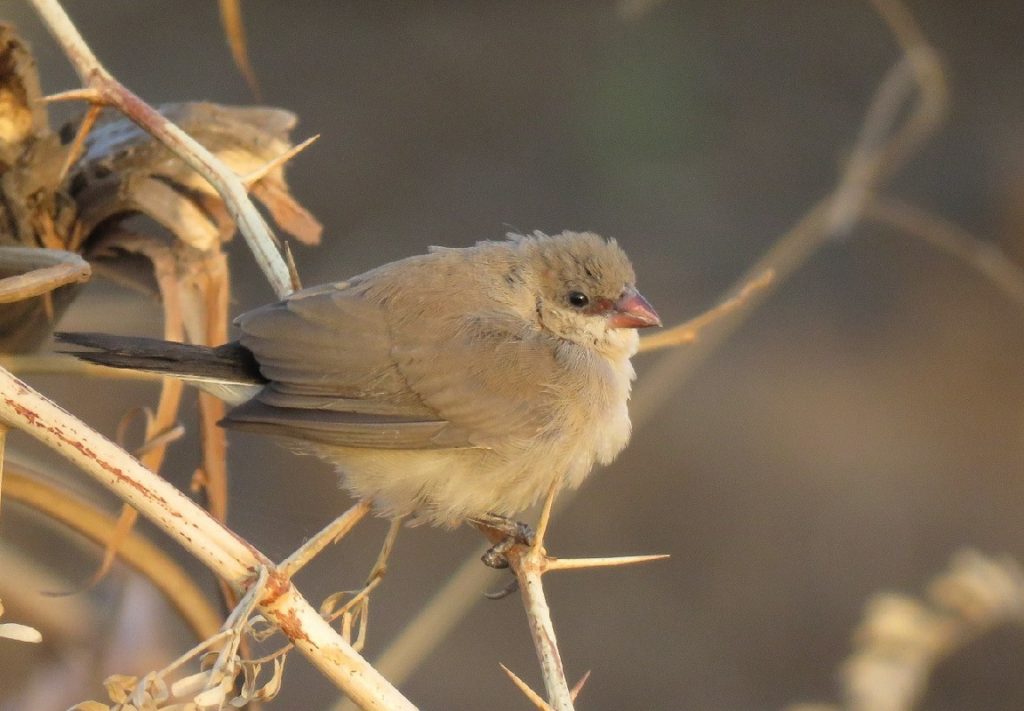
Black-rumped Waxbill, immature with bill turning from blackish to pale. (Pointe Sarene, Mbodiene, Senegal; December 2019.) © Bram Piot
Cf. Common Waxbill. Common and Black-rumped Waxbills are very similar and occur together naturally across the Sahel, south to Tanzania, and through introductions elsewhere. Both have pale brownish-gray plumage overall, with a crimson mask, coral-red bill, and usually a pinkish blush on the underparts that is strongest on the lower belly. The potential for confusion is especially high because Common’s pattern and coloration are highly variable.
Overall Coloration: In general, Black-rumped is uniformly pale, whereas most Commons are not. Common varies significantly so there are many exceptions, but most Commons have darker upperparts and a contrastingly pale throat and chest. Also, most Commons have a vivid scarlet patch on the belly that extends onto the breast, whereas Black-rumped tends to show a subtle pinkish blush throughout the breast and belly, with a bright red patch that is limited to the lower belly.
Barring: Both species may show fine barring on both the upperparts and underparts, but Common’s barring is usually far more pronounced, obvious on the upperparts and noticeable the underparts. For Black-rumped, it requires a close look to discern any barring on the upperparts, and probably requires a handheld examination or an exceptionally clear photograph to discern any barring on the underparts.
Vent: Black-rumped has a pale, usually whitish vent, whereas Common’s vent is dark, usually blackish. This seems to be a universal, objective distinction between the species—diagnostic in all cases.
Tail: Black-rumped’s is unmarked black or dark brown with white outer edges. Common’s tail is brown and distinctly barred.
Immatures. Immature plumages also differ in that Common has a red mask—generally duller and less extensive than the adult’s—whereas immature Black-rumped’s face is mostly brown with a small blackish mask.
Cf. Arabian Waxbill. The Red Sea separates the natural ranges of Black-rumped and Arabian Waxbills, but confusion would be possible if either species were out of its range—which happens frequently with Black-rumped in particular due to its popularity as a pet.
Arabian’s plumage is nearly identical to Black-rumped’s, including the tail, but its upperparts are grayer and more distinctly barred. The most conspicuous difference is that Arabian’s bill is always black. Immatures of the two species may be indistinguishable.
Cf. Crimson-rumped Waxbill. Black-rumped and Crimson-rumped Waxbills occur together in eastern Africa and possibly elsewhere through introductions. The adults are readily distinguishable, as their names suggest, but immatures can be very similar.
Immature Crimson-rumped typically has a rosy blush on its wings, rump, and vent, whereas immature Black-rumped has plain-brown wings, a dark rump, and whitish vent.
Notes
Monotypic species.
References
BirdLife International. 2018. Estrilda troglodytes. The IUCN Red List of Threatened Species 2018: e.T22719570A131994849. https://dx.doi.org/10.2305/IUCN.UK.2018-2.RLTS.T22719570A131994849.en. (Accessed April 4, 2020.)
Brazil, M. 2009. Birds of East Asia. Princeton University Press, Princeton, N.J.
Clement, P., A. Harris, and J. Davis. 1993. Finches and Sparrows: An Identification Guide. Princeton University Press, Princeton, N.J.
eBird. 2020. eBird: An online database of bird distribution and abundance. Cornell Lab of Ornithology, Ithaca, N.Y. http://www.ebird.org. (Accessed April 4, 2020.)
Hawaii Audubon Society. 2005. Hawaii’s Birds (Sixth Edition). Island Heritage Publishing, Waipahu, Hawaii.
Kirwan, G.M., A. Levesque, M. Oberle, and C.J. Sharpe. 2019. Birds of the West Indies. Lynx Edicions, Barcelona.
Payne, R. 2020. Black-rumped Waxbill (Estrilda troglodytes). In: del Hoyo, J., Elliott, A., Sargatal, J., Christie, D.A. & de Juana, E. (eds.). Handbook of the Birds of the World Alive. Lynx Edicions, Barcelona. https://www.hbw.com/node/61113. (Accessed April 4, 2020.)
Pyle, R.L., and P. Pyle. 2017. The Birds of the Hawaiian Islands: Occurrence, History, Distribution, and Status. Version 2 (January 1, 2017). http://hbs.bishopmuseum.org/birds/rlp-monograph/. B.P. Bishop Museum, Honolulu, Hawaii.
Raffaele, H., J. Wiley, O. Garrido, A. Keith, and J. Raffaele. 1998. A Guide to the Birds of the West Indies. Princeton University Press, Princeton, N.J.
van Perlo, B. 2002. Birds of Western and Central Africa. Princeton University Press, Princeton, N.J.
Xeno-Canto. 2020. Black-rumped Waxbill – Estrilda troglodytes. https://www.xeno-canto.org/species/Estrilda-astrild. (Accessed April 4, 2020.)

